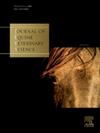Comparative analysis of equine semen preservation techniques and DNA damage detection using Comet and SCSA assays
IF 1.3
3区 农林科学
Q2 VETERINARY SCIENCES
引用次数: 0
Abstract
Maintaining the DNA integrity of equine spermatozoa during preservation is crucial for the success of assisted reproductive techniques. Sperm preservation generally relies on low temperatures to reduce or halt sperm metabolism to preserve functionality, but more recently methods of storing sperm above 15°C have been developed to reduce the effects of cold shock and cryodamage. The major damage that spermatozoa experience during preservation at any temperature is oxidative damage, which may lead to DNA damage. There are numerous DNA damage assays available, but their relative prognostic value in horses has yet to be evaluated. Therefore, the objective of the present study was to compare the sensitivity of two popular sperm DNA damage assays, the sperm chromatin structure assay (SCSA) and the single cell gel electrophoresis (neutral comet) assay in identifying sperm DNA damage in the horse. A total of 3 split ejaculates (diluted 2:1 with EquiPlus) from individual stallions were utilised. High-quality spermatozoa were isolated via single-layer colloidal centrifugation (EquiPure). Sperm pellets were resuspended in: L-EDTA cryodiluent with 20% egg yolk and 3% dimethylformamide; EquiPlus; and SpermSafe, after which they were either cryopreserved, chilled (5°C), or stored at 18°C respectively. The SCSA (DNA fragmentation index; DFI) and comet (tail intensity) analyses were performed at various relevant timepoints. While the SCSA revealed no significant increase in DNA damage at any timepoint, for any storage treatment, the comet assay was more sensitive, revealing a significant increase in DNA damage after 72h of storage in SpermSafe (0h: 21.1±11.4% vs 72h: 53.5±0.2%; p≤0.05), though this fell to non-significant levels by the 7-day timepoint (43.675±3.8%), and after cryopreservation (pre-freeze: 21.1±11.4% vs post-thaw: 67.2±3.5%; p≤0.05). There was no significant increase in DNA damage at any timepoint for the chilled, EquiPlus-stored samples. This study shows that the comet assay is more sensitive than the SCSA in detecting sperm DNA damage following various preservation methods. Notably, sperm stored in SpermSafe at 18°C exhibited unexpectedly high tail intensity, which contrasts with high pregnancy rates in commercial settings. We hypothesise that this may result from an artefact associated with capacitation-like changes and chromatin decondensation, due to the SpermSafe formulation mimicking oviduct fluid. Ongoing studies aim to investigate this further. Post-thaw, tail intensity (comet) more than tripled following cryopreservation, which could also be linked to capacitation-like changes or represent actual DNA damage that contributes to lower pregnancy rates seen with frozen-thawed sperm. A key limitation to this study is the small sample size, but additional replicates are being included in ongoing research. Despite this, our findings offer insights into sperm DNA integrity during preservation and suggest that the comet assay and SCSA may offer complementary prognostic value for equine assisted reproductive techniques.
马精液保存技术与DNA损伤检测的比较分析
在保存过程中保持马精子DNA的完整性对于辅助生殖技术的成功至关重要。精子保存通常依赖于低温来减少或停止精子代谢以保持功能,但最近已经开发出超过15°C的精子储存方法,以减少冷休克和冷冻损伤的影响。精子在任何温度下保存过程中所经历的主要损伤是氧化损伤,这可能导致DNA损伤。有许多DNA损伤检测方法可用,但它们对马的相对预后价值尚未得到评估。因此,本研究的目的是比较两种常用的精子DNA损伤检测方法,精子染色质结构检测(SCSA)和单细胞凝胶电泳(中性彗星)检测在识别马精子DNA损伤中的敏感性。共有3个分离射精(用EquiPlus稀释2:1)从单个种马被利用。通过单层胶体离心(EquiPure)分离出高质量精子。精子球用含20%蛋黄和3%二甲基甲酰胺的L-EDTA冷冻稀释液重悬;EquiPlus;和SpermSafe,之后分别冷冻保存、冷藏(5°C)或保存在18°C。DNA片段化指数;DFI)和彗星(尾部强度)分析在不同的相关时间点进行。尽管SCSA在任何时间点均未显示DNA损伤显著增加,但对于任何储存处理,彗星试验更为敏感,在SpermSafe中储存72h后显示DNA损伤显著增加(0h: 21.1±11.4% vs 72h: 53.5±0.2%;P≤0.05),但在7天时间点降至不显著水平(43.675±3.8%),超低温保存后(冷冻前:21.1±11.4% vs解冻后:67.2±3.5%;p≤0.05)。在任何时间点,冷冻的、equiplus储存的样品的DNA损伤都没有显著增加。本研究表明,彗星法在检测各种保存方法下精子DNA损伤方面比SCSA更敏感。值得注意的是,储存在SpermSafe中18°C的精子显示出出乎意料的高尾部强度,这与商业环境中的高妊娠率形成对比。我们假设这可能是由于SpermSafe配方模拟输卵管液导致的与能化样变化和染色质去浓缩相关的人工产物。正在进行的研究旨在进一步调查这一点。解冻后,尾部强度(彗星)在冷冻保存后增加了两倍多,这也可能与类似于能化的变化有关,或者代表了实际的DNA损伤,这导致了冷冻解冻精子的低怀孕率。本研究的一个关键限制是样本量小,但正在进行的研究中正在包括额外的重复。尽管如此,我们的研究结果提供了保存期间精子DNA完整性的见解,并表明彗星试验和SCSA可能为马辅助生殖技术提供互补的预后价值。
本文章由计算机程序翻译,如有差异,请以英文原文为准。
求助全文
约1分钟内获得全文
求助全文
来源期刊

Journal of Equine Veterinary Science
农林科学-兽医学
CiteScore
2.70
自引率
7.70%
发文量
249
审稿时长
77 days
期刊介绍:
Journal of Equine Veterinary Science (JEVS) is an international publication designed for the practicing equine veterinarian, equine researcher, and other equine health care specialist. Published monthly, each issue of JEVS includes original research, reviews, case reports, short communications, and clinical techniques from leaders in the equine veterinary field, covering such topics as laminitis, reproduction, infectious disease, parasitology, behavior, podology, internal medicine, surgery and nutrition.
 求助内容:
求助内容: 应助结果提醒方式:
应助结果提醒方式:


